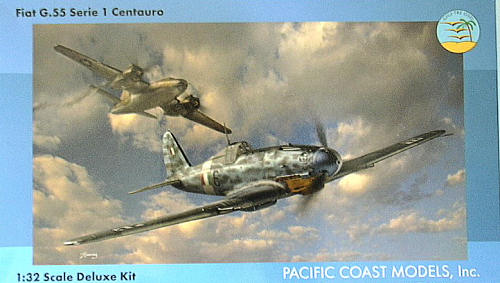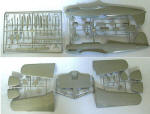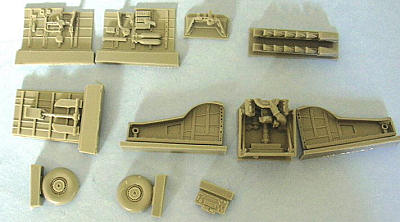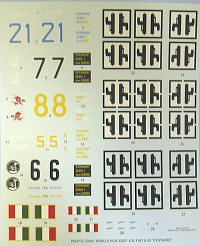
Pacific Coast 1/32 G.55 serie I
| KIT #: | 32007 |
| PRICE: | $64.95 MSRP |
| DECALS: | Five options |
| REVIEWER: | Tom Cleaver |
| NOTES: | Short run kit. |

| HISTORY |
Aviation historians commonly
consider the Fiat G.55 Centauro the
best single seat fighter produced for the Italian air force during the Second
World War.
The airplane clearly demonstrated parity with, if not
superiority, to the Bf-109G, the Fw-190A, the P-51D and the Spitfire IX,
demonstrating that the Italian aviation industry was capable of designing and
producing a world-class fighter.
Unfortunately for Italy (and fortunately for the
Allies), it came just too late to have a major effect on the conduct of the war.
The Fiat G.55 was Fiat’s answer to
a 1942 requirement placed by the Regia Aeronautica
for a fighter that would be designed from the outset to take advantage of the
German Daimler-Benz engine.
The previous fighters - the Macchi C.202 and the
Reggiane Re.2001 - had been developments of earlier designs to utilize the
Daimler-Benz DB601.
Named Centauro
the G.55 was a development of the G.50 Freccia,
though it owed little more than a general layout commonality to that fighter.
Fiat was fortunate that they had already been working on
an advanced design when the Regia Aeronautica
decided to produce a “third generation” fighter.
The previous design had been planned to utilize a
domestic high-performance engine which did not come to fruition.
Modification of the advanced design to utilize the
German DB605 engine was relatively easy, and it put Fiat ahead of its
competitors - Reggiane with their Re.2005 and Macchi with their C.205N and their
“stopgap” C.205V, with the Fiat prototype taking flight on April 30, 1942, well
before the competition.
The G.55 was originally designed
around an engine-mounted MG151 20mm cannon, with four Breda SAFAT 12.7mm machine
guns 9n the nose, firing through the propeller.
This became the Serie O,
12 of which were ordered as pre-production aircraft; these were the only G.55s
to see any service with the Regia Aeronautica prior to the Italian surrender in
September 1943, though their use was limited to interceptions of Allied bombers
in the vicinity of Rome prior to the declaration of Rome as an “open city.”
By May 1943, the
Serie I had flown with the central MG151, two
12.7mm machine guns in the upper forward fuselage, and an MG151 in each wing.
Italian pilots were elated when the Serie I proved
itself more maneuverable than either the Bf-109G or the Fw-190A in tests that
summer, with the Italian fighter being able to accelerate away from both German
fighters in a dive and only being inferior to the Focke-Wulf as regarded roll
rate.
By the time production began for
the Serie I in the fall of 1043, Italy had surrendered.
The pilots of the Serie O aircraft were all from
Northern Italy, an d since Fiat was based in Turin in the
Republica Sociale Italiana declared by Mussolini following
his rescue by the Germans, it was logical that the airplane would now become the
main equipment of the Aviazione Della R.S.I.,
the new Fascist Air Force, and several thousand G.55s were ordered.
Unfortunately, shortages of engines
began to develop quickly.
The license-built Italian engine of the DB605 was as
good as the license-built Italian version of the DB601 (not very), and the
Italians were forced again to depend on German production for their engines,
which put them at the end of the priority list after the DB605s were produced
for the Luftwaffe. In the end, due to
shortages and non-delivery of the DB 605A-1 engines, only
105 FIAT G55's were produced.
Force majeure required that the
Italian units re-equip with the Bf-109G, though some unofficial production of
the G.55 continued until the end of the war.
Following the end of the war, production of the G.55 resumed for foreign export with G.55A single-seaters and G.55B two-seat trainers built. The G.55A was armed with either 2 12.7mm machine guns or 2 20mm canon in the wing, plus the 2 12.7mm machine guns in the cowling. The postwar Italian Aor Force purchased 10 two-seaters and 9 fighters, while 30 - 15 G.55As and 15 G.55Bs - were sold to Argentina. Argentina returned 17 G.55As that were then sold to Egypt in 1948, though they did not take part in hostilities. The final version of the G.55 was the G.59, which was redesigned to use a Merlin engine. The Italian Air Force bought 10 single-seater and 10 two seater G.59s to use as fighter trainers in 1952-52, thus making the Fiat design the last piston-engine Italian fighter in production.
| THE KIT |
 This kit by Pacific Coast Models is
the first G.55 to appear in 1/32 scale, and continues the company’s
specialization of producing models of Italian aircraft.
As with the Reggianne Re.2005 and the Spitfire IX kits,
this kit is produced by Sword of the Czech Republic, with photo-etch from Eduard
and decals from Cartograph
This kit by Pacific Coast Models is
the first G.55 to appear in 1/32 scale, and continues the company’s
specialization of producing models of Italian aircraft.
As with the Reggianne Re.2005 and the Spitfire IX kits,
this kit is produced by Sword of the Czech Republic, with photo-etch from Eduard
and decals from Cartograph
The G.55 has had a spotty history
as a model. Back in the early 1970s, the company that later became Italerei
produced a 1/72 kit that was acceptable for the time and can still be found.
Earlier in the late 1960s, Merit had produced a G.55
that was really 1/50 scale though marketed as 1/48; it did superficially
resemble a G.55 and was released in the 1980s by SMER,
and may still be found.
This kit is only worthwhile if you are on a really tight
budget and price is your only consideration.
In the mid-1990, Classic Airframes produced a 1/48 G.55
that suffered from serious shape problems.
In 2007, Special Hobby released a G.55 with fuselages
allowing a modeler to do either the Serie O
or Serie I, and this is the best kit of
the airplane available in 1/48.
MPM/Special Hobby had announced last year that they
would produce a 1/32 kit, but they have been beaten to the starting gate by this
kit from Pacific Coast Hobbies.

 The kit is typical Sword: shiny
injection plastic, a bit thick, with panel lines that are slightly heavy but
will look OK under the proverbial coat of paint from my experience.
The cockpit and wheel wells and engine are done with
very crisp resin parts that are so well-done there are very few parts, yet the
result will look highly detailed.
Test-fitting the kit reveals that the fit of the plastic
parts is superior to that of the Re.2005 and somewhat better than the Spitfire
IX, both of which are very good examples of limited-run kits.
The two part canopy and windscreen are thick, but very
clear.
The kit is typical Sword: shiny
injection plastic, a bit thick, with panel lines that are slightly heavy but
will look OK under the proverbial coat of paint from my experience.
The cockpit and wheel wells and engine are done with
very crisp resin parts that are so well-done there are very few parts, yet the
result will look highly detailed.
Test-fitting the kit reveals that the fit of the plastic
parts is superior to that of the Re.2005 and somewhat better than the Spitfire
IX, both of which are very good examples of limited-run kits.
The two part canopy and windscreen are thick, but very
clear.
Decals are provided for five
aircraft flown by the Aviazione Della R.S.I..
Two are in dark green and grey, one (the boxart
airplane) is in German 74/75/76, one is in Dark Earth and Dark Green banded
markings, and the last is in the tri-color “splinter camouflage.”
| CONCLUSIONS |
From early work on the kit, this
looks to be the best G.55 available in any scale, and should result in a very
nice-looking model.
Thanks to Pacific Coast Models for the review kit.
December 2008
If you would like your product reviewed fairly and quickly, please contact me or see other details in the Note to Contributors.